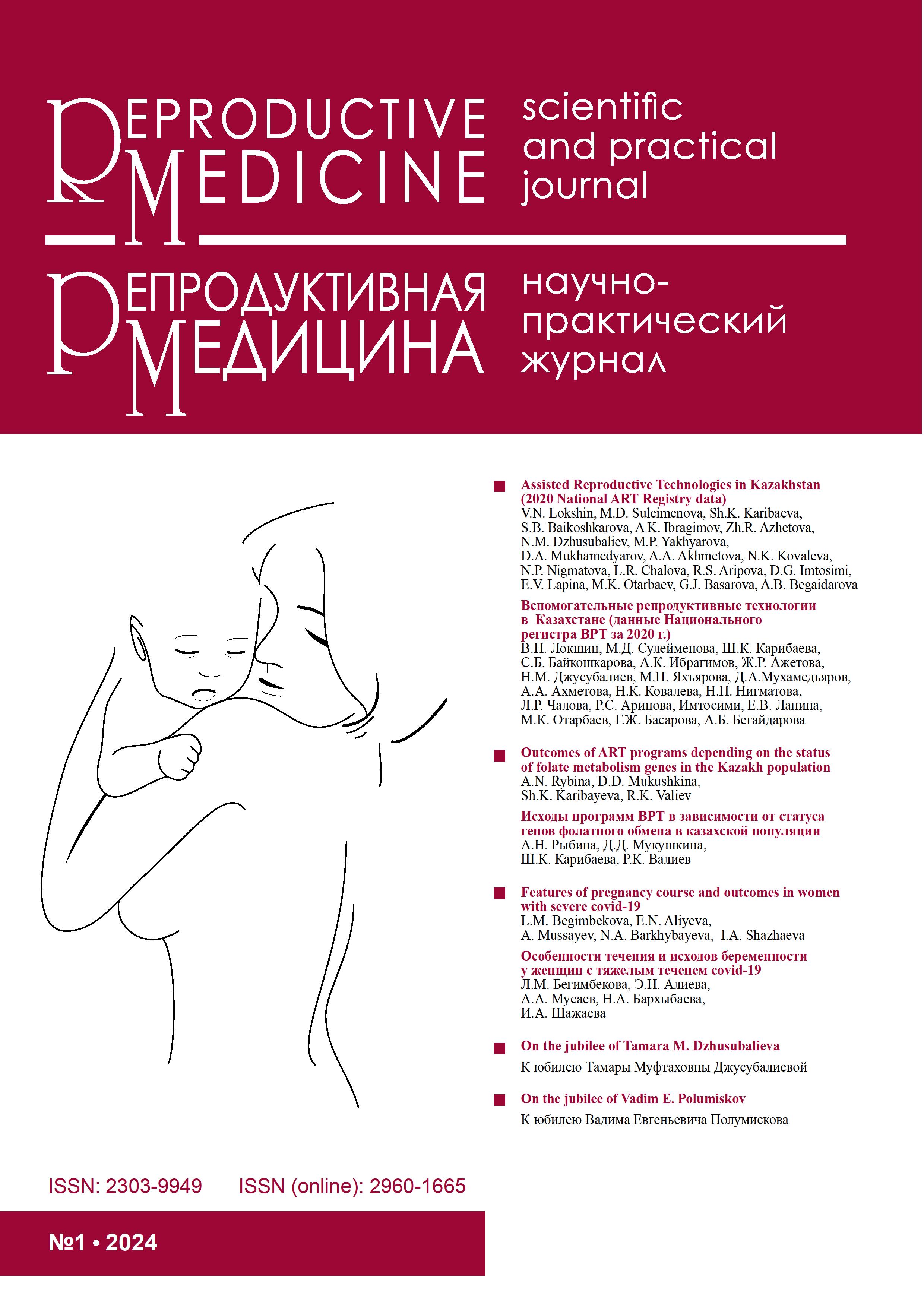Современный взгляд на проблему бесплодного брака: обзор литературы
DOI:
https://doi.org/10.37800/RM.1.2024.147-157Ключевые слова:
бесплодие, социальные аспекты бесплодия, влияния бесплодия на психическое здоровьеАннотация
Актуальность: Проблема бесплодия по-прежнему игнорируется в сфере сексуального и репродуктивного здоровья, но его последствия огромны. По оценкам Всемирной организацией здравоохранения (ВОЗ), от бесплодия страдают от 10 до 25% (от 48 до 180 миллионов) пар репродуктивного возраста во всем мире. Это связано с неблагоприятными последствиями бесплодия для физического и психического здоровья, серьезной социальной стигматизацией, повышенным риском домашнего насилия и нестабильностью в браке. Хотя мужчины и женщины в равной степени подвержены бесплодию, женщины часто несут социальное бремя бесплодия, особенно в обществах, где идентичность и социальная ценность женщины тесно связаны с ее способностью рожать детей.
Цель исследования – определение влияния бесплодного брака на социально-культурное здоровье супружеских пар.
Материалы и методы: Для достижения поставленной цели нами был проведен поиск в базах PubMed, Web of Science, Embase, Google Scholar, Ref list, PMC по ключевым словам: «бесплодие», «социальные аспекты бесплодия», «влияние бесплодия на психическое здоровье». В обзор включены 45 статей открытого доступа, опубликованных в 2017-2022 гг.
Результаты: Анализ результатов обзора показывает, что психологические последствия, экономические трудности, физическое здоровье влияют на состояние социально-культурного здоровья бесплодных пар. Результаты данного исследования могут быть учтены при ведении бесплодных пар с учётом их психологического состояния и социального положения и положительно повлиять на решение проблемы бесплодия.
Заключение: Результаты исследования имеют практическое значение и ключевые выводы информируют специалистов о важности уровней социально-культурного здоровья, связанного с бесплодием, и воспринимаемой социальной поддержки для выбора женщинами стратегий совладения, что полезно для разработки и адаптации вмешательств и стратегий консультирования супружеских пар. Результаты исследования свидетельствуют о необходимости пропаганды социальной политики для лучшей поддержки женщин с диагнозом бесплодие в частности и людей, включая как мужчин, так и женщин, с этой проблемой репродуктивного здоровья в целом.
Библиографические ссылки
World Health Organization. WHO fact sheet on infertility. Global Reprod Health. 2021;6(1):e52.
http://dx.doi.org/10.1097/GRH.0000000000000052
E.gov Ansagan Sabi [Internet]. cited: December 27, 2021.
https://egov.kz/cms/ru/articles/health_care/eco
Suleimenova M, Lokshin V, Glushkova N, Karibayeva S, Terzic M. Quality-of-Life Assessment of Women Undergoing In Vitro Fertilization in Kazakhstan. Int J Environ Res Public Health. 2022;19(20):13568.
https://doi.org/10.3390/ijerph192013568
Lokshin V, Omar M, Karibaeva S. Assisted Reproductive Technologies in the Republic of Kazakhstan: A 6-Year Trend Analysis from Efficacy to Availability. J Reprod Infertil. 2022;23:61-66.
https://doi.org/10.18502/jri.v23i1.8454
Локшин В.Н., Омар М., Карибаева Ш.К. Доступность лечения бесплодия с помощью ВРТ в различных социально-экономических группах. Обзор литературы. Репрод. мед. 2019;3(40):8-12.
Lokshin VN, Omar M, Karibaeva ShK. The availability of infertility treatment using ART in various socio-economic groups. Literature review. Reprod med. 2019;3(40):8-12. (in Russ.).
https://repromed.kz/index.php/journal/issue/view/27
Lokshin V., Omar M., Karibaeva Sh. Assisted Reproductive Technologies in the Republic of Kazakhstan: A 6-Year Trend Analysis from Efficacy to Availability. J Reprod Infertil. 2022;23(1):61-66.
https://doi.org/10.18502/jri.v23i1.8454
Practice Committee of the American Society for Reproductive Medicine. Definitions of infertility and recurrent pregnancy loss: A committee opinion. Fertil Steril. 2020;113:533-535.
https://doi.org/10.1016/j.fertnstert.2012.09.023
Datta J, Palmer MJ, Tanton C, Gibson LJ, Jones KG, Macdowall W, Glasier A, Sonnenberg P, Field N, Mercer CH. Prevalence of infertilityand help seeking among 15,000 women and men. Human Reprod. 2017;31:2108-2118.
https://doi.org/10.1093/humrep/dew123
Lasheras G, Mestre-Bach G, Clua E, Rodríguez I, Farré-Sender B. Cross-Border Reproductive Care: Psychological Distress in A Sample of Women Undergoing In Vitro FertilizationTreatment with and without Oocyte Donation. Int J Fertil Steril. 2020;14:130.
https://doi.org/10.22074/ijfs.2020.5997
Aimagambetova G, Issanov A, Terzic S, Bapayeva G, Ukybassova T, Baikoshkarova S, Aldiyarova A, Shauyen F, Terzic M. The effect of psychological distress on IVF outcomes: Reality or speculations? PLoS ONE. 2020;15:e0242024.
https://doi.org/10.1371/journal.pone.0242024
Bapayeva G, Aimagambetova G, Issanov A, Terzic S, Ukybassova T, Aldiyarova A, Utepova G, Daribay Z, Bekbossinova G, Balykov A. The effect of stress, anxiety and depression on in vitro fertilization outcome in kazakhstani public clinical setting: A cross-sectional study. J Clin Med. 2021;10:937.
https://doi.org/10.3390/jcm10050937
Micie J, Aimagambetova G, Terzic S, Bapayeva G, Kongrtay K, Laganà AS, Terzic M. Psychological factors and infertility. In: Advances in Health and Disease. New York, NY: Nova Science Publishers; 2021;38:67-95.
https://doi.org/10.3390/jpm12030431
Gurunath S, Pandian Z, Anderson RA, Bhattacharya S. Defining infertility: A systematic review of prevalence studies. Hum Reprod Upd. 2017;17(5):575-588.
http://dx.doi.org/10.1093/humupd/dmr015
Boivine J, Bunting L, Collins JA, Nygren KG. International estimates of infertility prevalence and treatment seeking: Potential need and demand for infertility medical care. Hum. Reprod. 2017;22(6):1506-1512.
http://dx.doi.org/10.1093/humrep/dem299
Mascarenhas MN, Cheung H, Mathers CD, Stevens GA. Measuring infertility in populations: Constructing a standard definition for use with demographic and reproductive health surveys. Popul Health Metrics. 2017;10(1):17.
http://dx.doi.org/10.1186/1478-7954-10-17
Polis CB, Cox CM, Tunçalp O, McLain AC, Thoma ME. Estimating infertility prevalence in low-to-middle-income countries: An application of a current duration approach to demographic and health survey data. Hum Reprod. 2017;32(5):1064-1074.
https://doi.org/10.1093/humrep/dex025
Adetoro OO, Ebomoyi EW. In vivo antiplasmodial activities and acute toxicity assessment of two plant cocktail extracts commonly used among Southwestern Nigerians. J Parasitic Dis. 2022;46(2):343-353.
https://doi.org/10.1007/s12639-021-01450-6
Starrs AM, Ezeh AC, Barker G, Basu A, Bertrand JT, Blum R, Ashford LS. Accelerate progress-sexual and reproductive health and rights for all: Report of the Guttmacher–Lancet Commission. Lancet. 2018;391(10140):2642-2692.
http://dx.doi.org/10.1016/S0140-6736(18)30293-9
Zegers-Hochschild F, Adamson GD, Dyer S, Racowsky C, De Mouzon J, Sokol R, Van der Poel S. The international glossary on infertility and fertility care. Fertil Steril. 2017;108(3):393-406.
https://doi.org/10.1016/j.fertnstert.2017.06.005
Randall AK, Bodenmann G. The role of stress on close relationships and marital satisfaction. Clin Psy Rev. 2019;29(2):105-115.
https://doi.org/10.1016/j.cpr.2008.10.004
Schmidt L, Holstein B, Christensen U, Boivin J. Does infertility cause marital benefit? An epidemiological study of 2250 women and men in fertility treatment. Patient Educ Counsel. 2017;59(3):244-251.
http://dx.doi.org/10.1093/humrep/der209
Peterson BD, Newton CR, Rosen KH. Examining congruence between partners’ perceived infertility-related stress and its relationship to marital adjustment and depression in infertile couples. Family Process. 2019;42(1):59-70.
https://doi.org/10.1111/j.1545-5300.2003.00059.x
Peterson BD, Newton CR, Rosen KH, Schulman RS. Coping processes of couples experiencing infertility. Family Relations. 2017;55(2):227–239.
https://doi.org/10.1111/j.1741-3729.2006.00372.x
Birenbaum Bell AV. I’m not really 100% a woman if I can’t have a kid: Infertility and the intersection of gender, identity, and the body. Gender Society. 2019;33:629-651.
http://dx.doi.org/10.1177/0891243219849526
Parrott FR. At the hospital I learnt the truth: Diagnosing male infertility in rural Malawi. Anthropology & Medicine. 2017;21(2):174–188.
https://doi.org/10.1080/13648470.2014.915618
Inhorn MC, Patrizio P. Infertility around the globe: New thinking on gender, reproductive technologies and global movements in the 21st century. Hum Reprod Upd. 2018;21(4):411-426.
http://dx.doi.org/10.1093/humupd/dmv016
Fledderjohann J. Difficulties conceiving and relationship stability in sub-Saharan Africa: The case of Ghana. Eur J Popul. 2017;33(1):129-152.
https://doi.org/10.1007/s10680-016-9401-5
Berntsen S, Söderström-Anttila V, Wennerholm UB, Laivuori H, Loft A, Oldereid NB, Romundstad LB, Bergh C, Pinborg A. The health of children conceived by ART: The chicken or the egg? Hum Reprod Upd. 2019;25(2):137-158.
http://dx.doi.org/10.3390/curroncol29080453
Rumbold AR, Moore VM, Whitrow MJ, Oswald TK, Moran LJ, Fernandez RC, Barnhart KT, Davies MJ. The impact of specific fertility treatments on cognitive development in childhood and adolescence: A systematic review. Hum Reprod. 2017;32(7):1489-1507. http://dx.doi.org/10.1093/humrep/dex085
Turkgeldi E, Yagmur H, Seyhan A, Urman B, Ata B. Short and long-term outcomes of children conceived with assisted reproductive technology. Eur J Obstet Gynecol Reprod. Biol. 2017;207:129-136.
http://dx.doi.org/10.1016/j.ejogrb.2016.10.010
Guo XY, Liu XM, Jin L, Wang TT, Ullah K, Sheng JZ, Huang HF. Cardiovascular and metabolic profiles of offspring conceived by assisted reproductive technologies: A systematic review and meta-analysis. Fertil Steril. 2017;107(3):622-631.
http://dx.doi.org/10.1016/j.fertnstert.2016.12.007
Thoma ME. Measuring infertility: Searching for consensus. J Women’s Health. 2015;24(7):541-543.
http://dx.doi.org/10.2471/BLT.20.252049
Fledderjohann J, Johnson DR. Impaired fertility and perceived difficulties conceiving in Ghana: Measurement problems and prospects. J Biosoc Sci. 2017;48(4):431-456.
http://dx.doi.org/10.1017/S0021932015000310
Olsen J, Juul S, Basso O. Measuring time to pregnancy. Methodological issues to consider. 2018;13(7):1751-1753.
http://dx.doi.org/10.1093/pubmed/fdn005
Jenkins J, Daya S, Kremer J, Balasch J, Barratt C, Cooke I, Nygren K. European Classification of Infertility Taskforce (ECIT) response to Habbema “towards less confusing terminology in reproductive medicine: A proposal. Hum Reprod. 2017;19(12):2687-2688.
http://dx.doi.org/10.1093/humrep/deh499
Ackerson K, Zielinski R. Factors influencing use of family planning in women living in crisis affected areas of sub-Saharan Africa: A review of the literature. Midwifery. 2017;54:35-60.
http://dx.doi.org/10.1080/23293691.2020.1820238
Larsen U. Research on infertility: Which definition should we use? Fertil Steril. 2018;83(4):846-852.
https://doi.org/10.1016/j.fertnstert.2004.11.033
Smarr MM, Sapra, KJ, Gemmill A, Kahn LG, Wise LA, Lynch CD, Buck Louis GM. Is human fecundity changing? A discussion of research and data gaps precluding us from having an answer. Hum Reprod. 2017;32(3):499-504.
http://dx.doi.org/10.1093/humrep/dew361
Gnoth C, Godehardt E, Frank-Herrmann P, Friol K, Tigges J, Freundl G. Definition and prevalence of subfertility and infertility. Human Reproduction. 2017;20(5):1144-1147.
https://doi.org/10.1093/humrep/deh870
Joffe M. Invited commentary: The potential for monitoring of fecundity and the remaining challenges. American Journal of Epidemiology. 2019;157(2):89-93.
https://doi.org/10.1093/aje/kwf177
Jacobson MH, Chin HB, Mertens AC, Spencer JB, Fothergill A, Howards PP. “Research on infertility: Definition makes a difference” revisited. Am J Epidemiol. 2018;187(2):337-346.
http://dx.doi.org/10.1093/aje/kwx240
Greil AL, Mc Quillan J, Johnson K, Slauson-Blevins K, Shreffler KM. The hidden infertile: Infertile women without pregnancy intent in the United States. Fertil Steril. 2017;93(6):2080-2083.
http://dx.doi.org/10.1016/j.fertnstert.2009.08.024
Slama R, Ballester F, Casas M, Cordier S, Eggesbo M, Iniguez C, Vrijheid M. Epidemiologic tools to study the influence of environmental factors on fecundity and pregnancy–related outcomes. Epidemiol Rev. 2014;36(1):148-164.
https://doi.org/10.1093/epirev/mxt011
Greil AL, Slauson-Blevins KS, Tiemeyer S, McQuillan J, Shreffler KM. A new way to estimate the potential unmet need for infertility services among women in the United States. J Women’s Health. 2017;25(2):133-138.
https://doi.org/10.1089/jwh.2015.5390
Журабекова Г.А., Тойчиева Г.К., Сарсенова Л.К., Оралхан Ж, Бершина Н.В., Бердалинова А.К., Бимаганбетова Л.Ш., Ким О.В., Балмагамбетова А.Д., Ахаева Т.А. Значение различных факторов в развитии женского первичного бесплодия: обзор литературы. Репродуктивная медицина. 2023;4(57):58-64.
Zhurabekova GA, Tojchieva GK, Sarsenova LK, Oralhan Zh, Bershina NV, Berdalinova AK, Bimaganbetova LSh, Kim OV, Balmagambetova AD, Ahaeva TA. The importance of various factors in the development of female primary infertility: a literature review. Reproduktivnaja medicina. 2023;4(57):58-64. (in Russ.).
Загрузки
Опубликован
Как цитировать
Выпуск
Раздел
Лицензия
Copyright (c) 2024 Права на принятую к публикации рукопись передаются Издателю журнала. При перепечатке всего материала или его части автор обязан сослаться на первичную публикацию в данном журнале.

Это произведение доступно по лицензии Creative Commons «Attribution-NonCommercial-NoDerivatives» («Атрибуция — Некоммерческое использование — Без производных произведений») 4.0 Всемирная.
Публикуемые в этом журнале статьи размещены под лицензией CC BY-NC-ND 4.0 (Creative Commons Attribution — Non Commercial — No Derivatives 4.0 International), которая предусматривает только их некоммерческое использование. В соответствии с этой лицензией пользователи имеют право копировать и распространять материалы, охраняемые авторским правом, но им не разрешается изменять или использовать их в коммерческих целях. Полная информация о лицензировании доступна по адресу https://creativecommons.org/licenses/by-nc-nd/4.0/.




